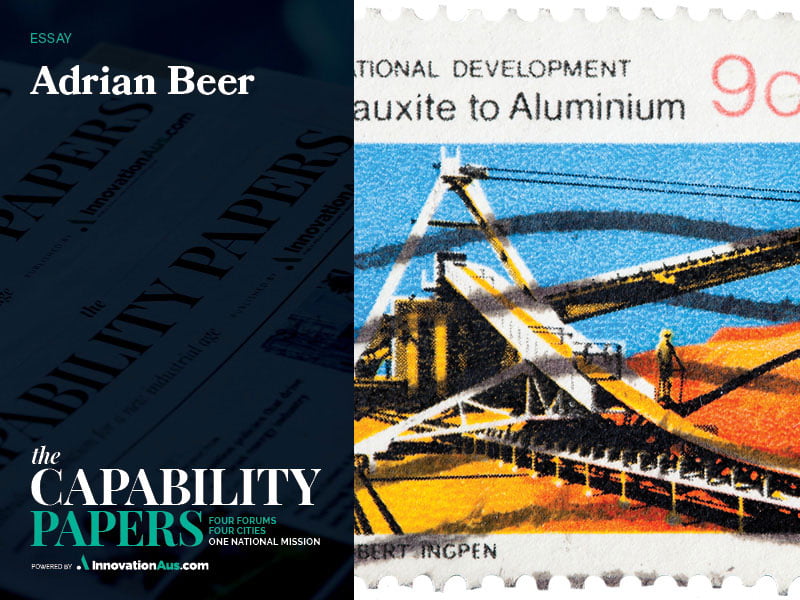Australia is often called out as a world leader in both research capability and innovative technologies, the beneficiary of decades of investment from our primary industries that make up the driving force of our economy.
While many nations dream of having the potential that we have in this country, back home we just can’t seem to work out how to capitalise. Be it productivity, economic complexity, access to labour or research investment, we seem to struggle in translation – converting capability into value.
As a nation we are indeed blessed, with a breadth of capability the envy of the world. Oddly, rather than backing ourselves, we expend an extraordinary amount of effort trying to emulate those nations who envy us.

We admire their achievements and mimic their programs, not realising these programs exist because they have to. Those nations must work harder because they simply don’t have what we take for granted.
Back home we all know there is much more potential, and yet we can’t get our act together. Many reminisce about the great days of yore, celebrating WiFi and solar panels, and mourning their loss offshore.
Others claim our ship has sailed, looking to pinpoint cause or point the finger of blame.
One thing we certainly are good at is gathering opinions, spending millions on advisors to tell us just how big the opportunity could be, and consultations and roadmaps to chart the pathway forward.
When you combine this with the multitude of thought leaders and opinion makers, it is hardly surprising that we can’t seem to work out where to start.
Now I don’t want to trivialise the problem. This is a unique challenge for our country, the product of many contributing factors. This is a complex issue for which there are no simple answers. But that doesn’t mean it is not worth fighting for.
It is never too late to back Australian ingenuity – and we must persevere if we want to realise more of our potential. And while some aspects will grab headlines and generate emotive responses, not all of them will.
I want to take this opportunity to share one of the less exciting barriers preventing us from realising our true capability; our national obsession with Intellectual Property (IP) … and the commercialisation of our research capability.
IP in Australia is a funny thing, particularly when juxtaposed with our abundant mineral wealth.
On one hand Australia desperately tries to export the maximum volume of our valuable commodities as quickly and as cost effectively as possible.
We know their immense value and their increasingly critical nature, and yet we are happy for anyone to come build a project and ship our valuable resources to anyone who wants to buy them. We even have a national strategy to encourage others to do so.
On the other hand, when a local researcher comes up with a novel idea on how to tackle a problem, the protectionist genie is unleashed! We wrap up the IP and lock it away – quickly mobilising our defences, consuming huge amounts of time and resources with absolutely no idea of its value or benefit.
Intellectual property rights in this country come up in discussions far too frequently, and are focused on way too early, compared with anywhere else in the world.
We are obsessed with IP – almost paralysed – unwilling to showcase capability before we have locked down who might own it. If you dare to arrange a conversation about a research partnership, it is NDAs at 30 paces before you can even set up a call.
While the US may be the most prolific with protectionist strategies when it comes to trade, I think even they would be wowed by the IP defence machinery in place within our research community.
Our research organisations and universities have commercialisation managers and entire departments protecting the future value of the unknown – preparing defence strategies and running scenario planning that would leave a seasoned army general blushing.
As a nation, how could we ever hope to set targets like three per cent GDP investment into research if nobody can access the benefits? Surely, we must make impact the objective, and when successful, increased investment will be the outcome.
This can only happen if we can realise a return. And to do so we will need to accept much more local risk. This is necessary if as a nation we want to take greater responsibility in translating our home-grown innovation.
We need to shift the focus from IP protection to value creation, or we will never benefit from our research capability. We have to stop building fortresses around our ideas, particularly before they can flourish.
I mentioned earlier this is a unique issue to Australia, so looking overseas for answers is an exercise in futility (no matter how much fun the study tour might be). This is a problem of our own making and requires national self-reflection to find solutions.
Looking back at some of our leading capabilities for inspiration, I thought our global experience in resources technology could be an easy place to start.
Back in the late 80s and early 90s, the global mining industry went through a technology revolution. The shift from analogue to digital brought in a new wave of industrial automation.
Mining companies invested heavily into process optimisation, building bespoke autonomous systems to increase throughput and drive down costs; investing heavily to build barriers in order to win the race to the bottom of the production cost curve.
As a nation, Australia was the first beneficiary in the adoption of autonomous vehicles. You would have seen images of these massive vehicles with big red numbers and no drivers, that frequent local news stories about the future of technology and automation.
The battle ground for autonomy created a misconception of the value of IP. When the first movers realised the advantage and benefits, they doubled down on the investment in autonomous systems and technology.
The major players became experts in defending and protecting their in-house IP, carving up knowhow to prevent anyone from learning too much. Unique insights were protected at all cost regardless of future value or worth.
But like all new innovations the market matured. Today there are numerous autonomous systems and technology companies all over the world. It is now all pervasive, with industry standards ensuring access for all.
We see consumer tech, defence and even the space sector building on the lessons learned from the remote autonomous operations of the mining industry.
And yet, although it was our backyard where this innovation battle occurred, today Australian companies play an insignificant part in the commercial supply of autonomous systems.
Like solar panels and battery energy storage systems, the market left us behind, and went where it was able to succeed. And for us as a nation, we again have become the trading partner (importer) of choice, paying a premium for buying capabilities we were implicit in creating.
Now don’t get me wrong, intellectual property is important. It is a mechanism by which companies can capture the value of their investment. It is also a fundamental building block of many competitive strategies. I am not against trademarks or IP. However…
If we truly want to unlock our local capability and translate it into value for the benefit of our economy, we must put IP back in its place. Not all IP is valuable, not all IP provides basis for competitive advantage and not all IP must be protected.
And we certainly don’t need to be designing complex IP management systems for something yet to be considered, let alone created.
Australia is full of vaults containing amazing innovation, of ‘stranded research outcomes’ just sitting on the shelf. We hold the keys to many amazing collaborative research efforts, locked away from view.
If we want to harness capability, then let’s tap this ‘latent potential’. Protected IP sitting on the shelf doing nothing is of no value to anyone.
We have to break down our IP protection barriers and complex licencing agreements if we want to maximise our impact.
We need to focus much more on value and getting to market first if we want to succeed and take true credit not just for invention but for impact.
And this is not a conservative approach. Lowering IP barriers will create risks. Changing our status quo will require bold ambition and intestinal fortitude.
But this is what it takes if we want to compete as a nation, if we want to stop innovation going overseas, and if we want to do more onshore.
It’s not just about capability, it is also what you do with it. And while it will be risky from where I sit, we have nothing to lose.
Adrian Beer brings extensive experience in the application of technology to the mining sector, and he is an advocate for cross-industry innovation and technology adaption. Adrian has held senior director or board advisory roles at SmartSat CRC, ABB, Austmine Limited, General Electric and the Newcastle Institute for Energy and Resources.
Purchase a copy of the The Capability Papers here.
Do you know more? Contact James Riley via Email.

